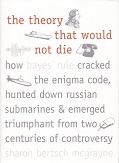Go to the Prior Tip
Exponential Utility Function testing limits"
Return to MaxValue Home Page
By Adam Kucharski, 2016, Basic Books, New York, ISBN 978-1-5416-9723-2 (paperback). (Amazon price 16-Feb-2018 $12.91)
I bought this book after reading a strong review. It did not disappoint.
Games of chance inspired early mathematicians and economists. Galileo, Kepler, Pascal, Bernoulli, Poincare--&233; or é--, and Pearson were early to investigate probability. Kucharski recognizes Ulam, von Neumann, Morgenstern, and Metropolis for Monte Carlo simulation and game theory. Of course, John Nash developed the game theory centerpiece, Nash equilibrium.
Math and physics “solve” some games. Brute-force modeling is another approach:
I was surprised to find the book turning increasingly toward robotics and modeling. Beyond gambling are applications to securities trading. Time is critical. Much investment in trading systems is to shave milliseconds off the time to place trades and to receive current quotes and latest trades. Faster connections are by means of trans-Atlantic cables, fiber optics, microwaves, and relocating servers to be adjacent to exchanges. High-frequency trading uses robots to place trades much faster than any human can. In the U.S. stock market, robots now make approximately half the trades.
Sometimes, robo-traders go badly awry. Kucharski described the famous Knight Capital incident in 2012. The company updated its trading software on seven of eight servers. They missed updating the eighth, and it started trading against the seven. The trading bots placed millions of orders in a few minutes. When Knight was finally able to stop its systems, they had lost $460 million (about $170k per second).
Information about what other players are thinking is valuable. A “sniffing algorithm” makes lots of little bets (or trades) to see what lurking big bets (or orders) might be out there. Conversely, a better (trader) can disguise his large bet (order) by making lots of small bets (trades).
Tic-tac-toe is an easy game, and most players quickly learn to play at the Nash equilibrium and never lose. Checkers has about 1020 possible board positions. Jonathan Schaeffer a the University of Alberta became interested in developing a checkers program in 1989. He and his team developed a robotic checkers program named Chinook. In 1992, Chinook played world champion Marion Tinsley. Chinook won two games, Tinsley four, and they had 33 draws. The university researchers went on to invent a perfect poker player that would never lose. In 2007, they published their paper, “Checkers is Solved.” Chess is vastly more complicated. Poker blends probability and psychology. An optimal poker strategy necessarily employs bluffing.
As often, knowledge arises from the pursuit of economic gains. Data analysis often precedes modeling. Correlation metrics suggest causal realationships. Unsupervised neural networks may prove predictive. Kucharski reveals some of the enormous efforts that have gone into developing gambling robots. Online gaming sites, similarly, needed to develop bots of their own to detecting betting bots.
Early gambling bot-builders incorporated game rules and betting-strategy rules. The computer could play thousands of games with human opponents or even billions of games against itself or other bots. The bots began discovering new rules unknown to the human designers. Surprisingly, optimal strategies require deviations from the apparent safe decisions.
The book quotes 18th-century mathematician Pierre Simon Laplace, “It is remarkable that a science which began with the consideration of games of chance should have become the most important object of human knowledge.”
For another interesting and very readable book about probability theory, I highly recommend The Theory That Would Not Die: How Bayes’ Rule Cracked the Enigma Code, Hunted Down Russian Submarines, and Emerged Triumphant from Two Centuries of Controversy by Sharon Bertsch McGrayne. She credits Laplace for independently inventing the form of Bayes’ rule in common use today.

—John Schuyler, February 2018.
Copyright © 2018 by John R. Schuyler. All rights reserved. Permission to copy with reproduction of this notice.